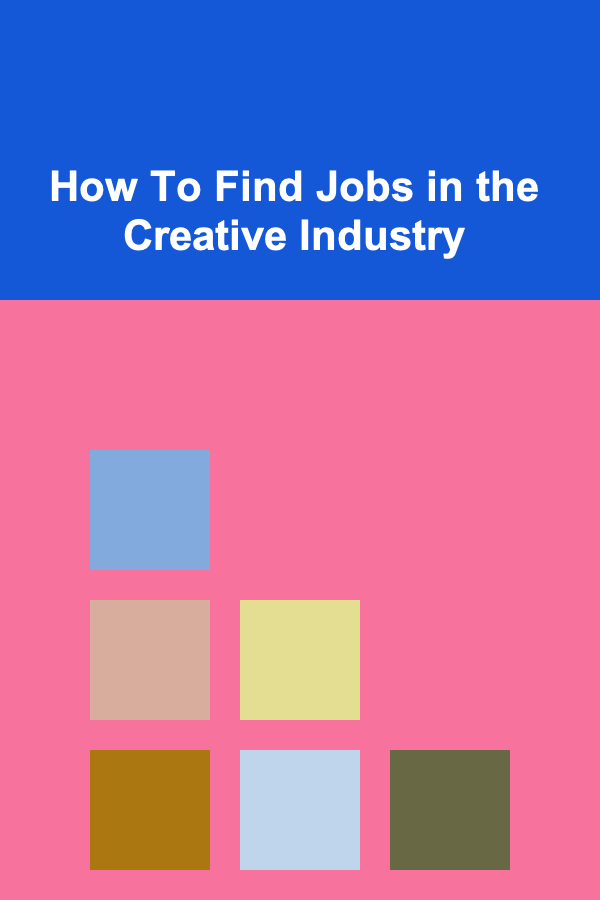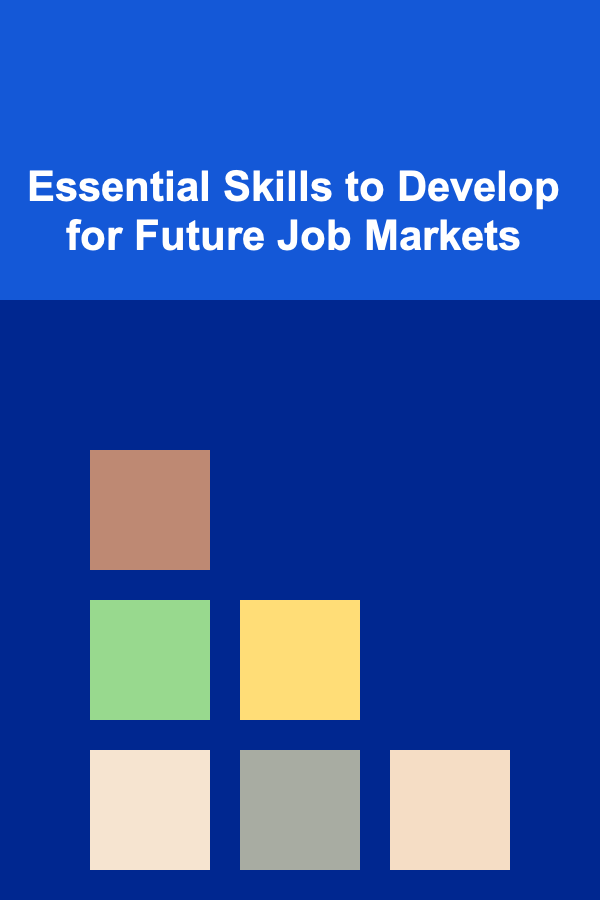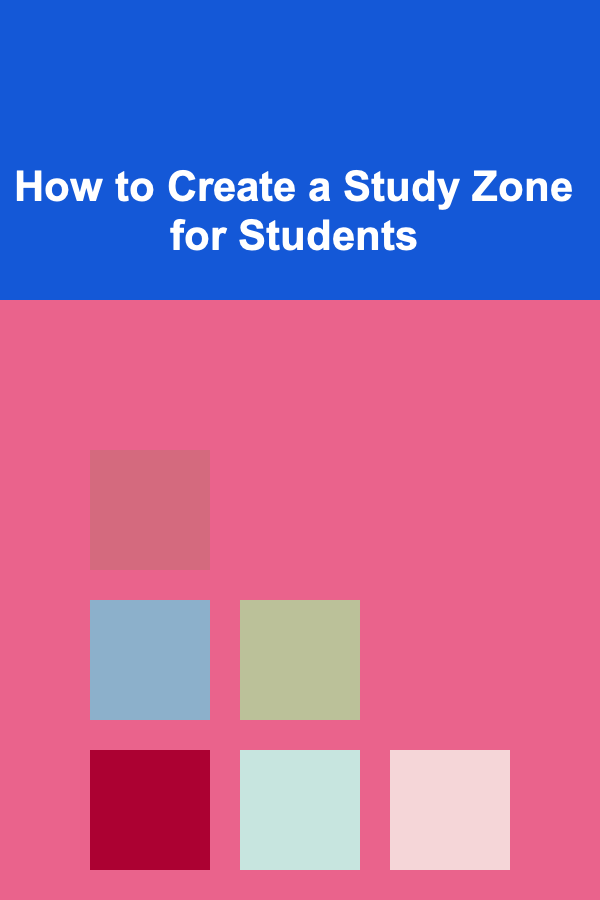
How To Find Jobs in the Creative Industry
ebook include PDF & Audio bundle (Micro Guide)
$12.99$9.99
Limited Time Offer! Order within the next:

The creative industry is a vast and diverse field that encompasses various sectors such as advertising, design, media, film, music, writing, and more. With the rapid evolution of digital platforms and global connectivity, the opportunities in the creative sector have expanded significantly, allowing individuals to carve out unique career paths. However, breaking into the creative industry can seem challenging, especially for those just starting their careers or those looking to transition from other fields. This guide aims to provide practical insights and strategies on how to find jobs in the creative industry, offering tips for success in a competitive environment.
Understand the Creative Industry Landscape
Before diving into job searches, it's important to grasp the diverse nature of the creative industry. The sector includes several distinct areas:
- Advertising & Marketing: Creative roles in this field involve developing campaigns, crafting compelling messaging, and creating visuals that resonate with consumers.
- Graphic Design & Visual Arts: These positions revolve around creating visual content, from logos and packaging designs to illustrations and interactive designs.
- Film & Television: Jobs in this area range from production roles like directing and cinematography to post-production roles such as editing, sound design, and visual effects.
- Music & Performing Arts: This encompasses music composition, performance, production, and stage design.
- Writing & Content Creation: Writers, editors, journalists, and bloggers create written content across different mediums, including books, articles, scripts, and digital content.
- Digital Media & Technology: This area includes roles related to video game design, web development, digital marketing, and social media management.
By recognizing the different paths within the creative industry, you can better focus your job search on roles that align with your skills and passions.
Build a Strong Portfolio
A portfolio is essential for showcasing your talent and work. In the creative industry, your portfolio serves as proof of your abilities and helps potential employers or clients evaluate your skill level. A strong portfolio should reflect your best work and demonstrate the range of your capabilities. Here are some key tips for building a successful portfolio:
- Highlight Your Best Work: Choose pieces that showcase your creativity, technical skills, and problem-solving abilities. Focus on quality over quantity.
- Tailor Your Portfolio to the Job: Customize your portfolio for the specific role or industry you're targeting. For instance, a designer's portfolio might emphasize visual work, while a writer's portfolio might focus on different styles of writing.
- Use a Digital Platform: A personal website or online portfolio (using platforms like Behance, Dribbble, or WordPress) makes it easier to share your work with potential employers and clients. It also demonstrates your ability to use digital tools effectively.
- Include Case Studies: Rather than simply showcasing finished projects, include brief explanations of the process, challenges, and outcomes. This will help employers understand your thought process and problem-solving abilities.
- Update Regularly: Keep your portfolio fresh by adding new projects and removing outdated or less impressive work. A constantly evolving portfolio signals growth and adaptability.
Network Within the Creative Community
Networking is one of the most effective ways to find job opportunities in the creative industry. Relationships are key in a field that values creativity, collaboration, and reputation. Here are some strategies for effective networking:
- Attend Industry Events: Conferences, workshops, webinars, and creative festivals are excellent places to meet industry professionals. Participate in events like Adobe MAX (for designers), Cannes Film Festival (for filmmakers), or SXSW (for a broad range of creative industries).
- Join Online Communities: Social media platforms like LinkedIn, Twitter, and Instagram, as well as specialized communities like Reddit's creative subreddits or Facebook groups, can help you connect with like-minded individuals. Engage by sharing your work, commenting on others' posts, and participating in conversations.
- Collaborate with Others: Creative professionals often work in teams. By collaborating with others, you can expand your network while improving your skills. Reach out to fellow creatives for joint projects or mentorship opportunities.
- Leverage Alumni Networks: Many universities and colleges have alumni networks that can help connect you with people in the industry. Attend alumni events or reach out to alumni who have pursued creative careers for advice and potential job leads.
Networking is not just about attending events or reaching out to people; it's about building genuine relationships that are mutually beneficial. It's important to be authentic, show interest in others' work, and offer value where possible.
Utilize Job Boards and Freelance Platforms
There are numerous job boards and platforms that specialize in creative industry positions. Some platforms focus on full-time positions, while others offer freelance opportunities. Here's a list of some popular platforms to explore:
- LinkedIn: LinkedIn is the world's largest professional network and a valuable resource for job seekers. You can search for jobs, follow companies of interest, and reach out to potential employers or collaborators.
- Indeed: While Indeed is a general job search engine, it frequently lists creative jobs, including design, writing, and media roles.
- Glassdoor: In addition to job listings, Glassdoor provides reviews of companies, which can be helpful when evaluating potential employers.
- Behance: A platform tailored to creative professionals, Behance is an excellent place to showcase your portfolio and discover job opportunities, particularly in design, animation, and illustration.
- Dribbble: Dribbble is a community of designers, offering a platform for creative professionals to showcase their work, find inspiration, and discover freelance or full-time job openings.
- Upwork: Upwork connects freelancers with clients seeking creative professionals for short-term and long-term projects. It's an ideal platform for those looking to build a portfolio and gain experience.
- Fiverr: Fiverr is another popular freelancing platform where creatives can offer their services, from graphic design to video editing, content writing, and more.
While these platforms are useful, it's important to use them strategically. Customize your resume and portfolio for each job application, and don't be discouraged by rejections. Persistence and consistency are key in landing a job in the creative industry.
Gain Experience Through Internships or Freelance Work
If you're just starting your career or transitioning into the creative industry, gaining experience is crucial. One effective way to build your experience is through internships or freelance work. Here's how they can help:
- Internships: Internships offer the opportunity to gain hands-on experience in the creative field, often at established companies. While some internships are unpaid, they can provide invaluable learning opportunities and connections. Internships can also serve as a stepping stone to full-time positions.
- Freelance Work: Freelancing allows you to work on various projects with different clients, giving you a broad range of experience. Freelance work can also help you build a portfolio quickly. Platforms like Upwork, Fiverr, or Freelancer are excellent places to find entry-level freelance gigs.
- Personal Projects: Working on personal creative projects---whether it's starting a blog, creating art, designing your own products, or producing music---can showcase your initiative, passion, and skills. Personal projects also offer a sense of ownership and can act as portfolio pieces when applying for jobs.
Both internships and freelance work offer the flexibility to explore different creative fields and discover what aligns best with your skills and interests. They also provide you with a real-world understanding of the industry and its demands.
Stay Up-to-Date with Industry Trends and Technologies
The creative industry is constantly evolving, with new trends, tools, and technologies emerging regularly. Staying current is essential for remaining competitive and relevant. Here's how to keep up:
- Follow Industry News: Subscribe to creative industry blogs, magazines, and newsletters. Websites like CreativeBloq, AIGA, and DesignTaxi provide regular updates on design trends, new tools, and industry news.
- Take Online Courses: Platforms like Skillshare, Coursera, and MasterClass offer courses taught by industry experts in various creative fields. Whether you want to learn new design software, improve your writing skills, or delve into photography techniques, there are endless opportunities for learning.
- Experiment with New Tools: Technology plays a significant role in the creative industry. Stay familiar with emerging software, platforms, and digital tools. For example, designers should be proficient in tools like Adobe Creative Cloud, while video editors should be skilled in programs like Final Cut Pro or DaVinci Resolve.
- Participate in Online Challenges: Platforms like 99designs, DeviantArt, and Instagram often host creative challenges that allow you to showcase your skills and gain exposure. These challenges can also help you stay motivated and continue improving your craft.
Remaining flexible, curious, and willing to learn will ensure you are well-prepared for the ever-changing demands of the creative industry.
Tailor Your Application and Approach
When applying for jobs, it's crucial to tailor your application materials to each specific opportunity. A generic resume or cover letter is unlikely to make a strong impression. Here's how to approach job applications effectively:
- Craft a Customized Resume: Highlight your relevant experience, skills, and projects. Focus on the most important aspects of your background that align with the specific job you're applying for.
- Write a Compelling Cover Letter: Your cover letter should reflect your enthusiasm for the job and explain why you're a great fit for the role. Be sure to mention your passion for the creative field and your commitment to contributing innovative ideas.
- Showcase Your Portfolio: Provide a link to your portfolio, ensuring it's easily accessible. In the application, refer to specific pieces that demonstrate your fit for the position.
- Follow Up: After submitting your application, follow up with a polite email thanking the hiring manager for their consideration and expressing continued interest in the position.
Being persistent and thoughtful in your application process will help set you apart from other candidates.
Conclusion
The creative industry offers endless opportunities for talented and passionate individuals. By building a strong portfolio, networking, gaining experience, staying updated with industry trends, and tailoring your job applications, you can successfully navigate the competitive landscape and land a job that aligns with your skills and aspirations. While the journey may be challenging, the rewards of working in a dynamic and innovative field are well worth the effort. Keep refining your craft, remain persistent, and take advantage of every opportunity to grow and showcase your talent.

Essential Skills to Develop for Future Job Markets
Read More
How to Conduct a Security Walkthrough of Your Property
Read More
How to Create a Study Zone for Students
Read More
How to Develop Large-Scale Solar Farms
Read More
How to Make Extra Income from Home by Starting a Global Side Hustle
Read More
How to Use Furniture to Define Different Areas in a Room
Read MoreOther Products

Essential Skills to Develop for Future Job Markets
Read More
How to Conduct a Security Walkthrough of Your Property
Read More
How to Create a Study Zone for Students
Read More
How to Develop Large-Scale Solar Farms
Read More
How to Make Extra Income from Home by Starting a Global Side Hustle
Read More